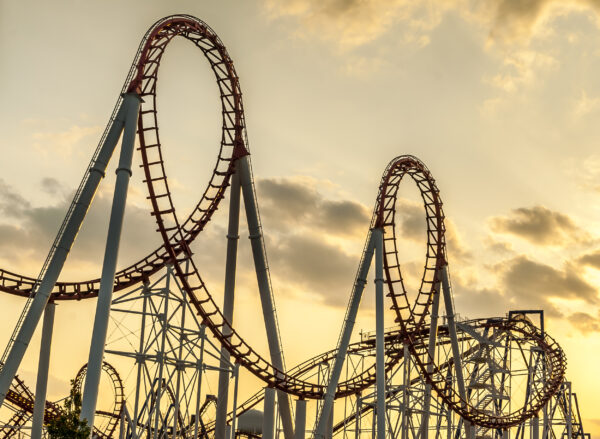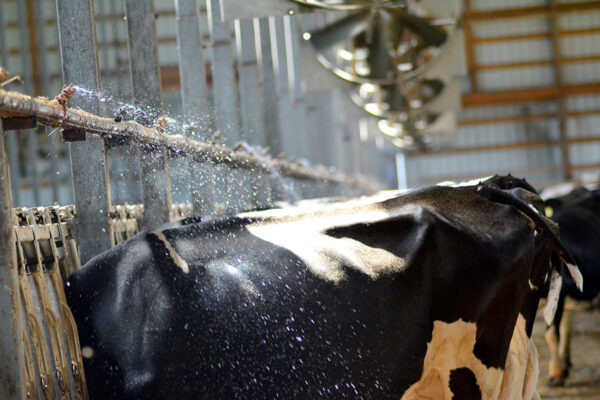Why Ride the Roller Coaster?
By Zach Janssen, DVM
I grew up not too far from Six Flags Great America. The American Eagle is the tallest and fastest racing wooden roller coaster in the world. Its first drop gives me the feeling most dairy farmers must have felt this spring, not exhilarating, but gut-wrenching. Mandates to dump milk and cut production combined with plummeting milk prices and uncertainty as far as the eye could see were enough to give anyone that nauseous feeling.
Not only does this beast of a roller coaster give you the up and downs, it also throws you side to side, giving you a thorough beating, just like this COVID-19 pandemic has done to our industry and our economy. In an effort to weather this brutal ride, many experts expounded on how to cut production (cull, dry off early, do 2X-milking, feed back the excess milk or, in worst cases, reduce energy in the diet). Now the roller coaster has caught the chain of government support, increased domestic demand and implementation of the U.S.-Mexico-Canada Agreement (USMCA) and is heading back up the hill. Have you prepared to take the ride?

Peak Milk
Our dairy cows also ride a bit of a roller coaster. After the stress of calving, which can be a real dip, the cow quickly climbs to her peak in milk production. Many factors can play a role in the height of this peak. Ease of transition, metabolic disease status and return to positive energy balance are just a few of these factors. If transition is successful and the peak is high, the cow should be able to coast to the end of lactation
“Each additional pound of peak milk production can
be worth 200-250 pounds more production over
the course of the entire lactation.”
For example, a cow that peaks at 100 pounds of milk may have a 305-day mature equivalent (ME) of 25,000 pounds. A cow that peaks at 105 pounds of milk would potentially make 26,250 pounds over the same time period. This difference could equate to hundreds of dollars of marginal income per cow. Are you prepared to maximize peak milk production and capture this additional income?
cow numbers
Several farmers chose to cull the bottom end of the herd to limit production and save resources. Others dried cows off early. Additionally, farmers have been using a strategy of selective crossbreeding on lower genetic animals, and now some are telling me they may face a shortage of replacements. Add all these factors together, and cow inventory numbers will be a challenge. With lower-than-expected cow numbers, maximizing production per cow will be the goal. To do this, they will need excellent nutrition, top-notch comfort and limited stress. During the summer months, bunk management, fly control and heat stress abatement will all be high on the list to prevent an unnecessary dip on the lactation curve tracks. Are these considerations you have prepared for?
Heat Stress
As we consider all the above factors, some of the toughest months of heat stress are upon us in the United States. Heat stress costs the dairy industry up to $1.5 billion annually. This equates to $100-150 per cow.
The obvious losses are in lower overall milk production and decreased components, lowering the value of the milk produced. A lagging, but very costly, result of heat stress is reproduction losses. Not only are conception rates decreased and early pregnancy losses increased, when the cows do become pregnant in the fall, they are set up to get on the roller coaster next lactation during the hot summer months. Perhaps, less obvious is the insidious increase in health events and lameness that can lead to unexpected early removal from the herd. Are you prepared to mitigate the effects of heat stress?

How to Prepare
1. Maximize cow comfort – New facilities are probably a stretch this year, however, several things can be done to keep the cow in her comfort zone. Evaluate stocking density. Maximum number of cows per pen does not equal optimal production per cow. Find the sweet spot. Increase bedding amounts and frequency to keep cows laying down and maximize their efficiency. Maintain existing stalls, fans and sprinklers.
2. Dry cows – Many used a strategy of drying cows off early to limit production. Longer dry periods could put these cows at risk of having too high of a body condition at calving; this in turn puts them at risk of several metabolic and infectious diseases, including retained placenta, hypocalcemia, metritis, ketosis and displaced abomasum. In addition, these dry cows will be calving in the peak of heat stress, and it is becoming clearer through research that long-term effects not only to these cows but also to their offspring can occur. Monitor body condition closely, maximize comfort and cooling, and boost the ration for these cows to ensure a smooth transition.
3. Herd inventory – Consider not only current cow numbers but also anticipated calving and culling. Not only is having adequate number of replacements important, so is the quality. Keep a close eye on overall parity of the herd, as higher parity cows are the most productive. If purchases are anticipated, develop a plan now to possibly lock in prices and work with the herd veterinarian to prevent introduction of disease into the herd. Also, consider timing and number of purchased replacements, as overwhelming the calving and fresh pens will have detrimental effects.
4. Cool cows – Constantly provide fresh water. Add water tanks to high traffic areas, especially outside of the milking parlor. Consider adding an electrolyte to stimulate water intake and absorption. Not only can beneficial electrolytes be added to water, they can also be incorporated into the feed to stimulate dry matter intake and cool cows from the inside out. Target the holding pen for improvements in airflow and cooling. Think about adding fans and sprinklers in cow pens to limit bunching and encourage lying in stalls.
5. Ration and additives – We all know that forage quality is critical. Stay on top of forage analysis as previous inventories dwindle and new crops come in. Short-term investments in feed additives can relieve stress, boost immune health, improve reproduction and maintain or increase milk production. These may include binders, probiotics including yeast, increased vitamins and minerals, and electrolytes. Many additives were removed this spring to cut costs. Work with your nutritionist and other advisors to put back in additives that offer a return on investment by boosting cow health and production.
To me, the best part of riding the American Eagle is pushing the bar forward and stepping back on the solid surface of the platform. This provides a sense of relief and certainty that I survived the ride. For the dairy industry, in the COVID-19 world, it is harder to see that platform at the end of the ride and trust that it will be solid when you step onto it. You may ask of my roller coaster riding, “Why do you put yourself in that situation?” as many outside of the dairy industry might ask of us. Perhaps it is the satisfaction of knowing we are creating a wholesome, nutritious product for our fellow citizens. Or, perhaps it is a love for this amazing creature called the cow that produces that product. Whatever the reason, we are inclined to take the ride over and over. Some enjoy the thrill of the ride; if you are like me, prepare yourself to get through it and back on the platform.
Article first published on Progressive Dairy. Why Ride the Roller Coaster
